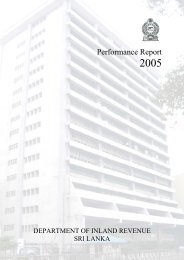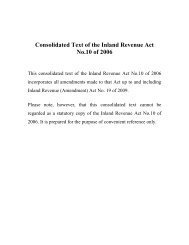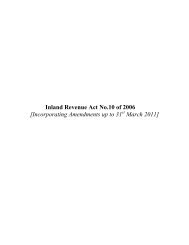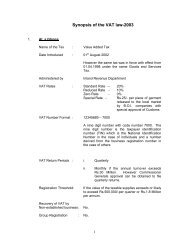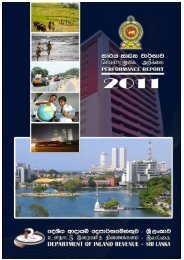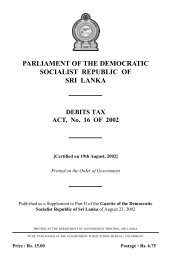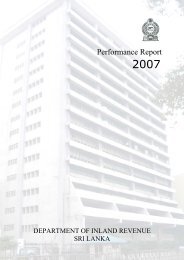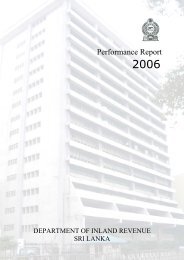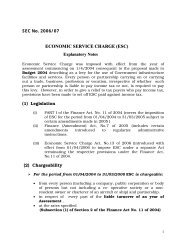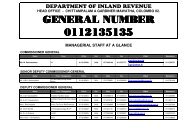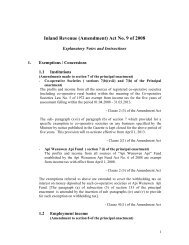VAT Guide to Value Added Tax - sri lanka inland revenue ...
VAT Guide to Value Added Tax - sri lanka inland revenue ...
VAT Guide to Value Added Tax - sri lanka inland revenue ...
Create successful ePaper yourself
Turn your PDF publications into a flip-book with our unique Google optimized e-Paper software.
Chapter - 1<br />
Introduction<br />
1.1 Purpose of this brochure<br />
This brochure provides a basic knowledge and guidance <strong>to</strong> the public and taxpayers on<br />
<strong>Value</strong> <strong>Added</strong> <strong>Tax</strong>. This is not an exhaustive document and does not cover special<br />
situations and exceptions <strong>to</strong> the general principles stated in the law. This will also serve<br />
as an introduc<strong>to</strong>ry manual <strong>to</strong> the officers.<br />
1.2 What is V.A.T?<br />
The <strong>Value</strong> <strong>Added</strong> <strong>Tax</strong> replaces the existing Goods and Services <strong>Tax</strong> but the concepts<br />
and principles of <strong>VAT</strong> are the same as those of GST with which you are already familiar.<br />
<strong>VAT</strong> is a tax on domestic consumption of goods and services. Thus goods imported in<strong>to</strong><br />
Sri Lanka and goods and services supplied within the terri<strong>to</strong>rial limits of Sri Lanka are the<br />
subject matter of this tax. It is a multi-stage tax levied on the incremental <strong>Value</strong> <strong>Added</strong> at<br />
every stage in the production and distribution chain of Goods and Services. The tax is<br />
borne by the final or the ultimate consumer of goods or service (Vide Para 9.5) He does<br />
not pay it direct <strong>to</strong> the government but <strong>to</strong> the ultimate supplier who supplied the goods or<br />
service <strong>to</strong> him. However the government will receive in the end, through all the<br />
intermediary suppliers in the chain of production and distribution, an amount equal <strong>to</strong> the<br />
amount paid by the final consumer, because each intermediary supplier in that chain is<br />
responsible <strong>to</strong> pay <strong>to</strong> the government, only the <strong>VAT</strong> he collects on the supplies made<br />
by him (output tax) less the <strong>VAT</strong> he paid on the supplies obtained by him (input tax).<br />
Thus the seller or the supplier of good/service does not pay tax himself as he is entitled<br />
<strong>to</strong> re-claim from the government the <strong>VAT</strong> he pays, on his fac<strong>to</strong>rs of production, from<br />
the monies that he collects for the government. He is a mere collec<strong>to</strong>r of tax, from the<br />
consumers, on behalf of the government. The <strong>VAT</strong> collected by him from his cus<strong>to</strong>mers<br />
is not a part of his profit or turnover because he is responsible <strong>to</strong> account for <strong>VAT</strong><br />
collected by him on every invoice. The collec<strong>to</strong>r (i.e the seller or suppler of<br />
good/service) becomes a “ trustee” for that money on behalf of the government.<br />
6



